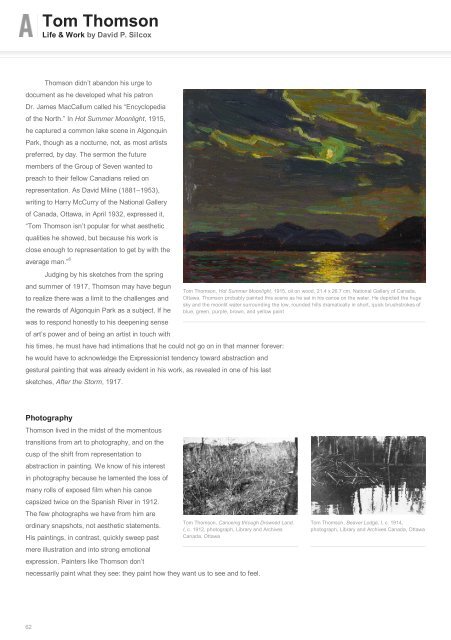You also want an ePaper? Increase the reach of your titles
YUMPU automatically turns print PDFs into web optimized ePapers that Google loves.
<strong>Tom</strong> <strong>Thomson</strong><br />
Life & Work by David P. Silcox<br />
<strong>Thomson</strong> didn’t abandon his urge to<br />
document as he developed what his patron<br />
Dr. James MacCallum called his “Encyclopedia<br />
of the North.” In Hot Summer Moonlight, 1915,<br />
he captured a common lake scene in Algonquin<br />
Park, though as a nocturne, not, as most artists<br />
preferred, by day. The sermon the future<br />
members of the Group of Seven wanted to<br />
preach to their fellow Canadians relied on<br />
representation. As David Milne (1881–1953),<br />
writing to Harry McCurry of the National Gallery<br />
of Canada, Ottawa, in April 1932, expressed it,<br />
“<strong>Tom</strong> <strong>Thomson</strong> isn’t popular for what aesthetic<br />
qualities he showed, but because his work is<br />
close enough to representation to get by with the<br />
average man.”<br />
6<br />
Judging by his sketches from the spring<br />
and summer of 1917, <strong>Thomson</strong> may have begun<br />
to realize there was a limit to the challenges and<br />
the rewards of Algonquin Park as a subject. If he<br />
was to respond honestly to his deepening sense<br />
of art’s power and of being an artist in touch with<br />
his times, he must have had intimations that he could not go on in that manner forever:<br />
he would have to acknowledge the Expressionist tendency toward abstraction and<br />
gestural painting that was already evident in his work, as revealed in one of his last<br />
sketches, After the Storm, 1917.<br />
<strong>Tom</strong> <strong>Thomson</strong>, Hot Summer Moonlight, 1915, oil on wood, 21.4 x 26.7 cm, National Gallery of Canada,<br />
Ottawa. <strong>Thomson</strong> probably painted this scene as he sat in his canoe on the water. He depicted the huge<br />
sky and the moonlit water surrounding the low, rounded hills dramatically in short, quick brushstrokes of<br />
blue, green, purple, brown, and yellow paint<br />
Photography<br />
<strong>Thomson</strong> lived in the midst of the momentous<br />
transitions from art to photography, and on the<br />
cusp of the shift from representation to<br />
abstraction in painting. We know of his interest<br />
in photography because he lamented the loss of<br />
many rolls of exposed film when his canoe<br />
capsized twice on the Spanish River in 1912.<br />
The few photographs we have from him are<br />
ordinary snapshots, not aesthetic statements.<br />
His paintings, in contrast, quickly sweep past<br />
mere illustration and into strong emotional<br />
expression. Painters like <strong>Thomson</strong> don’t<br />
<strong>Tom</strong> <strong>Thomson</strong>, Canoeing through Drowned Land,<br />
I, c. 1912, photograph, Library and Archives<br />
Canada, Ottawa<br />
necessarily paint what they see: they paint how they want us to see and to feel.<br />
<strong>Tom</strong> <strong>Thomson</strong>, Beaver Lodge, I, c. 1914,<br />
photograph, Library and Archives Canada, Ottawa<br />
62


